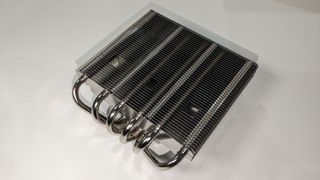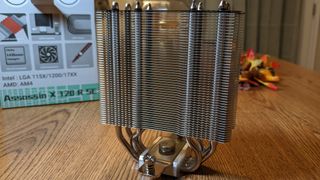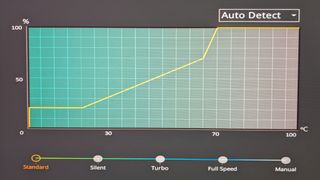Core i9-13900K Cooling Guide: Testing Intel's Flagship With Budget Air and Big AIOs
The Core i9-13900K can push even the most capable liquid coolers to their limits, but you don’t lose that much performance if you go with budget-priced air cooling.

When Intel launched its 12th generation Alder Lake CPUs, the Core i9-12900K presented a challenge to cool in some scenarios, due to the increased thermal density of the Intel 7 manufacturing process. But with the launch of Raptor Lake and the Core i9-13900K specifically, Intel has raised both the core count and clock speeds of its latest flagship processor. As a result, when power limits are removed, it can consume over 330W while running Cinebench R23 – nearly 100W higher power consumption than the i9-12900K – and that’s not easy to cool.
We’ll be looking at Intel’s Core i9-13900K below, and what it takes to cool it. Intel recommends that you use a 240mm AIO cooler or greater (or air equivalent) for the Core i9-13900K. While we expect most enthusiasts will pair an i9 CPU with high-end air or liquid cooling, we’ll also be testing with more basic air coolers to see what can be gained or lost with different levels of cooling.
New Testing Configuration
| CPU | Intel i9-13900K |
| Comparison Air Coolers Tested | DeepCool AG620, dual tower air cooler |
| Thermalright Assassin X 120 R SE, single tower air cooler | |
| Thermalright AXP120-X67, SFF air cooler | |
| Comparison AIO Coolers Tested | DeepCool LT720 (360mm) |
| Motherboard | Asus TUF Gaming Z690 Plus Wifi DDR5 |
| RAM | Crucial DDR5-4800 |
| GPU | Intel ARC A770 LE |
| Case | Cooler Master HAF 700 Berserker |
| PSU | Cooler Master XG Plus 850 Platinum PSU |
For today’s test we’ll be testing an entry-level air cooler, a high-end air cooler, and a high-end liquid cooler to see how different levels of cooling impact Raptor Lake.
Starting with an SFF cooler, we’ll be testing using Thermalright’s AXP120-X67.

We’ll also be testing Thermalright’s Assassin X 120 R SE to show more typical low-end cooler results. This is an entry-level, single-tower air cooler that can be found for around $20.

To give an idea of how higher-end air coolers will perform with the i9-13900K, we’re testing DeepCool’s AG620, a dual-tower air cooler which is a slightly modified version of the previously reviewed AK620.

We’ll also be testing DeepCool’s recently released LT720 360mm AIO liquid cooler to see how top-tier liquid cooling will impact Raptor Lake. The LT Series is the successor to the LS series of AIOs, which were strong coolers when paired with Intel’s 12900K.
Stay On the Cutting Edge: Get the Tom's Hardware Newsletter
Get Tom's Hardware's best news and in-depth reviews, straight to your inbox.

Testing Methodology
While in the past a CPU hitting its peak temperature was cause for concern, enthusiasts are going to have to learn to accept high temperatures as “normal” while running demanding workloads with Raptor Lake and Ryzen 7000 CPUs.
Modern AMD & Intel CPUs are designed to run fairly hot without any problems – up to 95 degrees Celsius for AMD Ryzen 7000 CPUs, and up to 100 degrees C for Intel Raptor Lake CPUs. Similar behavior has been standard in laptops for years due to cooling limitations.
Furthermore, Intel’s i9-13900K supports Adaptive Boost Technology (ABT), which allows Core i9 processors to dynamically boost to higher all-core frequencies based upon available thermal headroom and electrical conditions. This allows multi-core loads to operate at up to 5.5ghz if the necessary amount of thermal dissipation is there. This feature works in a way that actively seeks high temperatures: If the chip sees that it is running below the 100-degree C threshold, it will increase its performance and power consumption until it reaches the safe 100C limit, thus sustaining higher clocks (and providing better performance) for longer periods.
While it was fairly easy with previous generations of CPUs for coolers to keep the processor well under TJ max (the maximum temperature a CPU can sustain without throttling) in demanding workloads, this is no longer realistically possible on current generation CPUs without extreme cooling (or enabling power limits).
When I began testing coolers on Intel’s i9-12900K, I found that many products that cooled the i9-10900K well now struggled in some scenarios when paired with the Alder Lake CPU – and Raptor Lake is even more difficult to cool in these situations.
The increased cooling challenges posed by Raptor Lake mean that we’ve had to change some of the ways we test. Some coolers were able to pass Cinebench R23 multicore testing with Intel’s 12th Gen i9-12900K when power limits were removed, although only the strongest models were able to pass that test. Most liquid coolers and all air coolers I’ve tested “failed” that test because the CPU reached TJ max (the highest temperature before throttling) in this scenario.
With Raptor Lake’s 13900K, not a single cooler tested has been able to keep the CPU under TJ max in this test. And as we stated above, that’s because the Raptor Lake flagship is designed to dial up power until it hits that temperature. We’ll compare performance instead by comparing total benchmark scores and clock speeds maintained.
I’ll be testing Intel’s i9-13900K CPU using Asus’ TUF Gaming Z690 Gaming Plus WIFI motherboard and Cooler Master’s HAF 700 Berserker computer case, with case fans limited to 35% speeds. The motherboard’s default fan curve is used for the CPU Cooler’s fans.

In addition to testing Cinebench without power limits enforced, we’ll also be showing results when the CPU’s power consumption is limited to a more reasonable 200W. We’ll also show results at 125W for those who prefer whisper-quiet cooling, at the cost of some performance. For both of these results, we’ll show traditional delta over ambient temperature results.
LGA1700 Socket Bending
Please note there are many factors other than the CPU cooler that can influence your cooling performance, including the case you use and the fans installed in it. A system's motherboard can also influence this, especially if it suffers from bending, which results in poor cooler contact with the CPU.
In order to prevent bending from impacting our cooling results, we’ve installed Thermalright’s LGA 1700 contact frame into our testing rig. This means that if your motherboard is affected by bending, your thermal results will be worse than those shown below. Not all motherboards are affected equally by this issue. I tested Raptor Lake CPUs in two motherboards. And while one of them showed significant thermal improvements after installing Thermalright’s LGA1700 contact frame, the other motherboard showed no difference in temperatures whatsoever!
- MORE: Best CPU Coolers
- MORE: Raptor Lake All We Know
- MORE: How to check CPU Temperature

Albert Thomas is a contributor for Tom’s Hardware, primarily covering CPU cooling reviews.
-
-Fran- Holy cow, I know you teased this yesterday in the Discord, but great work with this investigation.Reply
There's still a few things I'd like you to check (using the normal ILM*, for instance) and include that data, but overall, this is mighty impressive.
Great work.
Regards. -
rluker5 Reply
Don't do it Al, It's a trap!-Fran- said:Holy cow, I know you teased this yesterday in the Discord, but great work with this investigation.
There's still a few things I'd like you to check (using the normal ILS, for instance) and include that data, but overall, this is mighty impressive.
Great work.
Regards.
No way would I take my 13900kf that is a virgin to that ILS and soil it. Sure my 12700k didn't see much difference in temps with my Prime Z690 P ILS, but there was a depression that will always be there at least a little.
But a typical gaming heavy power use test (like uncapped framerate at low resolution in CPU demanding game X with a potent GPU) with the different coolers, showing their clockspeeds and temps with no power limits would be nice. Maybe in a future article. Just to show a real world performance example for the 99%.
Also as a side note, I saw a 200W max power dissipation in CB23 with my 12700k with a Mugen B, 240W with a NH-D15, and 260W on a 13900kf+CB23 with a Cooler Master ML280 in my personal, less controlled use. -
-Fran- Reply
That is one of the other things I would have liked to see: a gaming test with those same conditions and coolers.rluker5 said:Don't do it Al, It's a trap!
No way would I take my 13900kf that is a virgin to that ILS and soil it. Sure my 12700k didn't see much difference in temps with my Prime Z690 P ILS, but there was a depression that will always be there at least a little.
But a typical gaming heavy power use test (like uncapped framerate at low resolution in CPU demanding game X with a potent GPU) with the different coolers, showing their clockspeeds and temps with no power limits would be nice. Maybe in a future article. Just to show a real world performance example for the 99%.
Also as a side note, I saw a 200W max power dissipation in CB23 with my 12700k with a Mugen B, 240W with a NH-D15, and 260W on a 13900kf+CB23 with a Cooler Master ML280 in my personal, less controlled use.
I think the selection of coolers is quite fine, since it's covering what I'd consider the good reasonable range (maybe adding a 240 AIO would be good?) and it demonstrated via CB, that after a certain point, the CPU even if throttling still performs fine-ish. The caveat is the noise, since it's pegged at 100% everything, but still performs close to what you'd like/expect.
Overall, Intel came out better than what I would have expected to be honest, so I'd love to see those additions to this piece and then do the same testing on Ryzen and other Intel models (although I think it's fair to extrapolate from highest SKU).
Regards. -
rluker5 It would be good to see game clocks on Ryzen. I think CPUs have gotten large enough and are turned up fat enough that all of the high end ones reduce their clocks somewhat doing things like CB23 and P95, just like GPUs and furmark. I know Intel clocks and behavior under less than max stress just fine, Ryzen clock behavior under those conditions with different coolers is still a mystery to me. The converse may be true for many Ryzen owners.Reply -
baboma ReplyI would advise against running the 13900K without power limits. Because attempting to cool a CPU that’s using over 300W results in a lot of fan noise and heat output for very little increased performance.
I wholeheartedly agree with this recommendation. While there'll always be people who wants balls-out speed and hang the noise/power, using power limits (for both Intel & AMD) is a much more reasonable approach for the vast majority, and cheaper, if you want to use a budget air cooler.
It's good to see that the 13900K can be cooled to 74C at peak load with a cheap cooler, using a 200W power limit. I hope this puts to rest all the partisan carping about RPL needing expensive high-end AIOs. People always tend to believe the worst in things they don't like.
This said, if a person has enough funds to spring for a ~$600 CPU, it's probably safe to say that it won't be paired with a cheapo cooler. But at least the option is there.
I'm not sure about the wisdom of buying a flagship CPU only to substantially reduce its power (to 125W) for the sake of quietness. If such were the goal, the person should buy a cheaper and lower-powered part to begin with.
Lastly, I would like to see R23 bench numbers for the 125W and 200W power levels, and not just temp. -
Giroro I'm not seeing the CB scores and frequency to go with temperatures for the lower power limits. That would have been interesting data.Reply -
TerryLaze Reply
For the 200W one nothing would change in clocks and performance since the weakest cooler manages an avg of 198W already.Giroro said:I'm not seeing the CB scores and frequency to go with temperatures for the lower power limits. That would have been interesting data.
And the 125W is basically just there to show the reduction in noise (due to the lower temps) as many already said nobody is going to get that CPU to run it at a locked 125W so performance at that point isn't relevant.
Not for comparing cheap coolers.
Starting with the Thermalright SFF cooler, clocks of 4722MHz were maintained consuming 198W on average.
-
JamesJones44 Reply-Fran- said:That is one of the other things I would have liked to see: a gaming test with those same conditions and coolers.
I think the selection of coolers is quite fine, since it's covering what I'd consider the good reasonable range (maybe adding a 240 AIO would be good?) and it demonstrated via CB, that after a certain point, the CPU even if throttling still performs fine-ish. The caveat is the noise, since it's pegged at 100% everything, but still performs close to what you'd like/expect.
Overall, Intel came out better than what I would have expected to be honest, so I'd love to see those additions to this piece and then do the same testing on Ryzen and other Intel models (although I think it's fair to extrapolate from highest SKU).
Regards.
PCWorld did this a little bit (from a power draw point of view). The results show it's pretty equal to what you had with the 12900k
Edit: Fixed the image preview size (a width of 120 was a little hard to read :D). -
-Fran- Reply
It has been done in several places, but in open benches with 360AIOs or custom loop, so not quite the same.JamesJones44 said:PCWorld did this a little bit (from a power draw point of view). The results show it's pretty equal to what you had with the 12900k
Edit: Fixed the image preview size (a width of 120 was a little hard to read :D).
From what I read and understood, Albert tested inside a case with each one of the coolers mentioned. It's quite a different test. Quite harsher as well.
Regards. -
TerryLaze Reply
That depends on many factors, inside a case you can have good airflow so ambient temps, as far as cooling is concerned, would be lower than just the room temp you would have in an open case/testbed scenario.-Fran- said:From what I read and understood, Albert tested inside a case with each one of the coolers mentioned. It's quite a different test. Quite harsher as well.
Also flowing air transfers more heat away from the cooler than static air.
If they use a glass coffin type case with zero airflow then yes, it would be much harsher.
Most Popular


